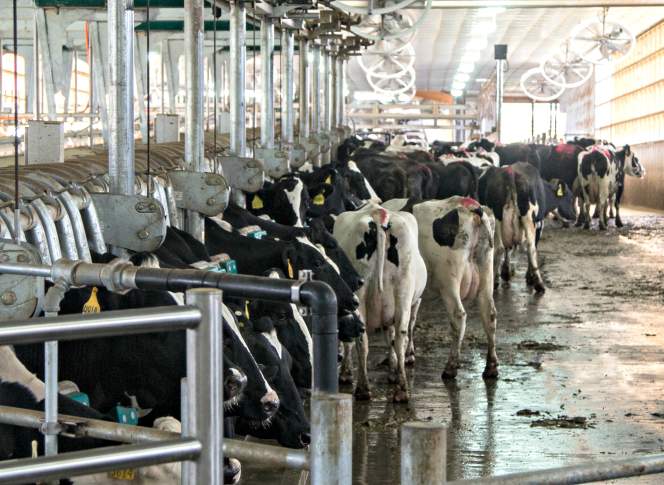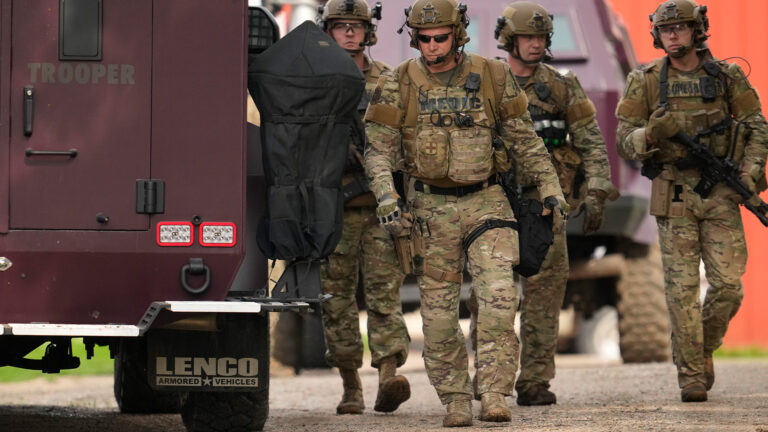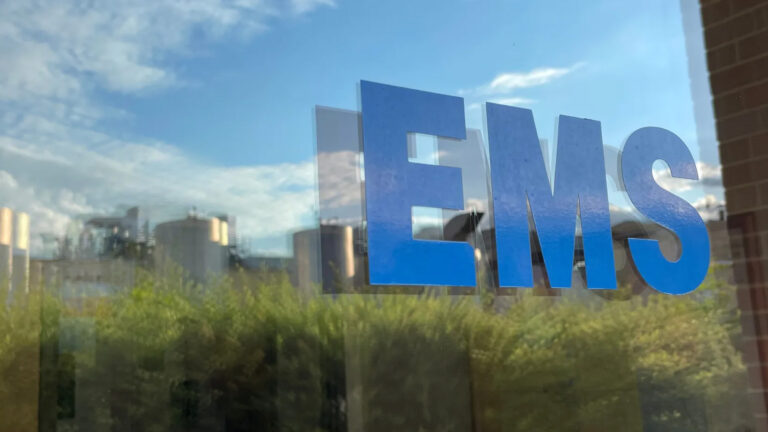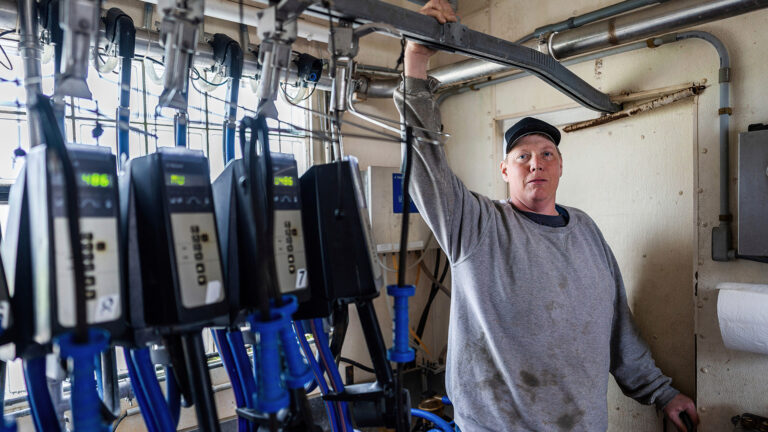Why Wisconsin's Livestock Farms Are Growing In Size
Farms that raise animals — be they poultry, pigs, cows or other livestock — are growing. But whether smaller farms are simply updated with modern technologies or are concentrated animal feeding operations with hundreds or thousands of animals, they enable farmers to reduce costs and increase output.
September 21, 2016

Statz Brothers dairy farm in Dane County

In recent decades, farms have been getting bigger and more specialized. Those farms that raise animals — be they poultry, pigs, cows or other livestock — are growing too. But whether smaller farms are simply updated with modern technologies or are concentrated animal feeding operations with hundreds or thousands of animals, they enable farmers to reduce costs and increase output, thus helping them to grow their profits and maintain their business.
Zen Miller, agricultural dairy and livestock agent for University of Wisconsin-Extension Outagamie County, shared observations and statistics about modern livestock production systems in a July 30, 2015, presentation in Ashland. His talk was part of the Northern Lights tour put on by the Wednesday Nite @ the Lab lecture series and was recorded for Wisconsin Public Television’s University Place. Ashland is a few miles from a proposed swine CAFO in Bayfield County that is the focus of ongoing disputes over its potential effects on the region and the scope of local regulatory authority.
In his talk, Miller discussed how many dairy farms have updated their facilities and technology, growing larger and more efficient. This modernization involved converting from barns in which cows were placed in a stall and secured with a rope or metal frame (called a stanchion) to a “milking parlor” that facilitates an assembly line approach, increasing efficiency and reducing physical stress on farmers.
Miller recounted data from a 2008 UW survey of 99 small to average size dairy farms across 30 Wisconsin counties. Modernized operations increased herd size from 82 to 203 animals on average, and annual milk production increased from 20,245 to 21,684 pounds per cow, he noted. The amount of acreage these farms owned and rented increased too, as did the amount of labor used. The number of milk cows per full-time worker on a farm increased from 35 to 50.
The use of a milking parlor means cows can be handled more efficiently. In this study, 74 percent of the farmers said their production increased. In addition, they spent less time feeding and handling cows, and handling their manure.
The dairy farmers in the study reported benefits to their businesses and quality of life. Seventy-eight percent of respondents said modernization and the efficiencies it afforded let them spend more time with their families. Increased farm income made bringing adult children into the business more feasible. Milking parlors improved farmer health due to reduced stress injuries because farmers no longer squatted next to cows and were less likely to get kicked or pushed, Miller said.
The cows themselves also benefit, the farmers reported. Miller said cows in modernized settings have fewer problems with their feet and legs, fewer infections and a greater conception rate. The farms’ cull rate declined.
Miller also discussed challenges associated with the odor and manure generated by livestock, explained how a farm with 1,000 to 1,200 dairy cows houses, and feeds its animals and manages their manure. He showed photos of barns common to CAFOs. The number of dairy CAFOs with Wisconsin permits increased from about 50 in 2000 to more than 250 in 2014; permits for poultry, swine and beef have been stable. (The Wisconsin Department of Natural Resources defines CAFOs by the number of its “animal units” and connections to navigable waters and groundwater wells.)
Key facts
- Three percent of the earth’s land and less than 1 percent of the earth’s water is available for farming. At the same time, the world’s population is growing and with it demand for more food.
- Dairy farms are declining in number as average herd size is increasing. U.S. dairies use 65 percent less water and 90 percent less land in the 2010s than they did in 1944, while pork producers use 78 percent less land.
- The number of Wisconsin dairy farms has decreased, but the number of cows is stable or increasing. From 2007 to 2012, the number of herds with 50 to 99 cows declined by 1,919, while the number of herds with 200 to 499 cows increased from 750 to 815.
- A free stall barn has high side walls and curtains the farmer can open in the summer to let air circulate. Newer, technologically updated barns also can have fans and water cooling systems that sprinkle livestock to cool them.
- A concentrated swine feeding operation Reicks View Farms has proposed in Bayfield County would have three barns. Its gestation and breeding barn would be 900 by 120 feet in size. Its farrowing barn would be 700 by 140 feet. A third barn would be for developing gilts, which are young, female pigs raised for breeding. Proponents say the operation would create 30-35 jobs, and its construction would have an economic impact of $3 million.
- Modern swine barns keep animals cleaner than earlier structures did. Floors are designed with slats to allow urine and feces to fall through, which keeps swine away from their own waste and the gasses it creates. A clean environment is important for keeping pigs healthier and reducing exposure to disease.
- Swine operations often seek isolated areas for siting in order to improve their biosecurity and avoid the risks of animal diseases.
Key quotes
- On feeding more people: “[W]e’re just looking and concerned about how many people we have, and the need to have food for everybody. And as our population increases their income, they want high quality protein, and so we’re going to need more food as we go along by 2050.”
- On robots feeding cows: “In the … barn, you see the feed alley, so they can drive by and feed cows. They can push it up. And the most, newest technology out there is they actually have a robot called Juno… It travels up and down the alley … however many times you want it to in a circular motion, pushing up feed.”
- On farm animal odor: “[O]dor is a little different on a dairy farm than a swine farm. And how you store your manure makes a difference on what type of smell you have a little bit as well. I have a trained nose. I can drive down the Interstate 80 in Iowa and I can say, ‘there’s beef cattle on feed, and they’re on a high corn diet’ by smelling. And you can also drive down the road, and you can say, ‘somebody’s feeding pigs somewhere close here, because I can smell them.'”
- On the advantages of manure: “The nice thing about having manure from your animals is that there is a certain amount of phosphorus in it. Some of the soils as you get in northern Wisconsin are very low in phosphorus.”
- On how pork production has changed: “When I was a kid, we raised everything on the farm. We raised pigs outside. We thought our pigs were pretty good, and we sold them when they weighed 220 pounds. Now, farmers generally specialize, and if you raise pigs you may not raise anything else. They’re usually raised in barns. They’re leaner, and we don’t sell them until they weigh 280 pounds apiece. And they’re still leaner even though they’re 60 pounds bigger.”
- On keeping the farm in the family: “It used to be a father would try to line up his three or four sons on three or four different farms. Now, a farmer today might line up one farm with multiple enterprises and bring his three or four sons in. It’s just a little more efficient for them.”
 Passport
Passport












Follow Us